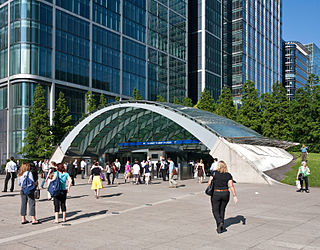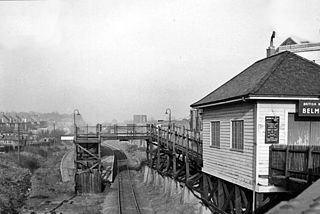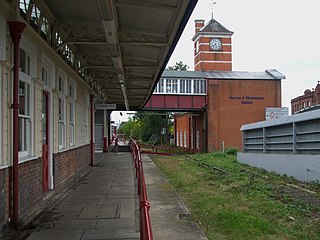
The Bakerloo line is a London Underground line that runs from Harrow & Wealdstone in suburban north-west London to Elephant & Castle in south London, via the West End. Printed in brown on the Tube map, it serves 25 stations, 15 of which are underground, over 23.2 kilometres (14.4 mi). It runs partly on the surface and partly through deep-level tube tunnels.

The Jubilee line is a London Underground line that runs between Stanmore in suburban north-west London and Stratford in east London, via the Docklands, South Bank and West End. Opened in 1979, it is the newest line on the Underground network, although some sections of track date back to 1932 and some stations to 1879.

Stanmore is part of the London Borough of Harrow in Greater London. It is centred 11 miles (18 km) northwest of Charing Cross, lies on the outskirts of the London urban area and includes Stanmore Hill, one of the highest points of London, at 152 metres (499 ft) high. The district, which developed from the ancient Middlesex parishes of Great and Little Stanmore, lies immediately west of Roman Watling Street and forms the eastern part of the modern London Borough of Harrow.

The London Borough of Harrow is a London borough in northwest London, England; it forms part of Outer London. It borders four other London boroughs – Barnet to the east of ancient Watling Street, Brent to the southeast, Ealing to the south and Hillingdon to the west – plus the Hertfordshire districts of Three Rivers and Hertsmere to the north. The local authority is Harrow London Borough Council. The London borough was formed in 1965, based on boundaries that had been established in 1934. The borough is made up of three towns: Harrow, Pinner and Stanmore, but also includes western parts of Edgware.

Baker Street is a London Underground station at the junction of Baker Street and the Marylebone Road in the City of Westminster. It is one of the original stations of the Metropolitan Railway (MR), the world's first underground railway, opened on 10 January 1863.

Canary Wharf is a London Underground station at Canary Wharf and is on the Jubilee line, between Canada Water and North Greenwich stations. The station is located in Travelcard Zone 2 and was opened on 17 September 1999 as part of the Jubilee Line Extension. Over 40 million people pass through the station each year, making it second busiest on the London Underground outside Central London after Stratford, and also the busiest that serves only a single line.

Kilburn is a London Underground station near Brondesbury Park in north-west London. It is on the Jubilee line, between Willesden Green and West Hampstead stations and is in Travelcard Zone 2. The station is on the A5 Kilburn High Road or Shoot-up Hill, approximately 0.1 miles (0.16 km) north of Brondesbury station. Metropolitan line trains typically bypass the station without stopping.

Swiss Cottage is a London Underground station at Swiss Cottage, north London. It is on the Jubilee line, between Finchley Road and St John's Wood stations. It lies in Travelcard Zone 2 and is located at the junction of Finchley Road, Avenue Road and College Crescent. The station is a local station, with the Metropolitan Line bypassing the station nearby.

Canons Park is a London Underground station at Canons Park of the London Borough of Harrow, north-west London. It is on the Jubilee line, between Stanmore and Queensbury stations and is in Travelcard Zone 5. It is also the least used station on the Jubilee line with an average of 1.68 million passengers per year.

Stanmore is a London Underground station in Stanmore, north-west London. It is the northern terminus of the Jubilee line and the next station towards south is Canons Park. The station is on the south side of London Road and is in Travelcard Zone 5.

Winchester railway station is a railway station in Winchester in the county of Hampshire, England. It is on the South West Main Line and was known as Winchester City from 1949–67 to distinguish it from Winchester (Chesil) station. It is 66 miles 39 chains (107.0 km) down the line from London Waterloo.

Stanmore is a suburb in the Inner West of Sydney, in New South Wales, Australia 6 kilometres south west of the Sydney central business district. It is part of the local government area of the Inner West Council. It is known for its long strip of shops running along Parramatta Road.

Belmont was a station in Belmont, north-west London on the Stanmore branch line. It was opened on 12 September 1932 by the London, Midland and Scottish Railway as the only intermediate station on a short branch line running north from Harrow & Wealdstone to Stanmore, in anticipation of the Metropolitan Railway opening its own branch line to a new Stanmore station the same year.

Stanmore Village railway station was a station in Stanmore, Middlesex in the south of England. Originally called simply Stanmore, it was opened on 18 December 1890 by the Harrow and Stanmore Railway, a company owned by the hotel millionaire Frederick Gordon, as the terminus of the Stanmore branch line, a short branch line running north from Harrow & Wealdstone. Trains were operated by the London & North Western Railway (LNWR).

Queensbury is an area of northwest London, England, in the southeast of the London Borough of Harrow on the boundary with the London Borough of Brent. The area is split between four postal districts: Harrow HA3, Stanmore HA7, Edgware HA8, and London NW9.
Stanmore station could refer to either:
Stanmore Country Park could refer to:
John Warner was an English academic, cleric, and physician. He was the first Regius Professor of Physic at the University of Oxford, as well as the Vice-Chancellor of the University of Oxford and the Dean of Winchester.

The Stanmore branch line was a railway line in Harrow, Middlesex, in the United Kingdom. Located to the north of London, it provided commuter rail services between Harrow and the village of Stanmore. Beginning at Harrow station, the line split off from the West Coast Main Line and followed a short 2.12-mile (3.41 km) route to Stanmore.

Stanmore is a large residential suburb of Winchester, Hampshire, England, situated on a very steep slope from West to East. It lies to the south-west of the city centre and to the north of Badger Farm, and makes up a large percentage, in both area and population, of the St. Luke electoral ward. It is home to roughly 6,000 inhabitants.
















